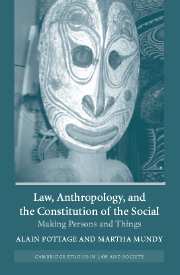Book contents
- Frontmatter
- Contents
- Notes on contributors
- 1 Introduction: the fabrication of persons and things
- 2 Res Religiosae: on the categories of religion and commerce in Roman law
- 3 Scientific objects and legal objectivity
- 4 Legal fabrications and the case of ‘cultural property’
- 5 Ownership or office? A debate in Islamic Hanafite jurisprudence over the nature of the military ‘fief’, from the Mamluks to the Ottomans
- 6 Gedik: a bundle of rights and obligations for Istanbul artisans and traders, 1750–1840
- 7 Losing (out on) intellectual resources
- 8 Re-visualising attachment: an anthropological perspective on persons and property forms
- 9 Our original inheritance
- Bibliography
- Index
3 - Scientific objects and legal objectivity
Published online by Cambridge University Press: 12 July 2009
- Frontmatter
- Contents
- Notes on contributors
- 1 Introduction: the fabrication of persons and things
- 2 Res Religiosae: on the categories of religion and commerce in Roman law
- 3 Scientific objects and legal objectivity
- 4 Legal fabrications and the case of ‘cultural property’
- 5 Ownership or office? A debate in Islamic Hanafite jurisprudence over the nature of the military ‘fief’, from the Mamluks to the Ottomans
- 6 Gedik: a bundle of rights and obligations for Istanbul artisans and traders, 1750–1840
- 7 Losing (out on) intellectual resources
- 8 Re-visualising attachment: an anthropological perspective on persons and property forms
- 9 Our original inheritance
- Bibliography
- Index
Summary
PORTRAIT OF THE CONSEIL D'ETAT AS A LABORATORY
‘Those are the facts, like it or not’; ‘we have reached our decision, whether it pleases you or not’: the solidity of facts and the rigour of the law both have a kind of hardness which compels assent. What makes a comparison between the world of science and that of law all the more interesting is that both domains emphasise the virtues of a disinterested and unprejudiced approach, based on distance and precision, and in both domains participants speak esoteric languages and reason in carefully cultivated styles. Also, both scientists and judges seem to attract a kind of respect that is unknown in other human activities. The comparison I shall try to make in this chapter is not so much between ‘science’ and ‘law’ as it is between two laboratories, that of my friend Jean Rossier at the Ecole de Physique-Chimie, and that of the Conseil d'Etat.
Rather than base my comparison on what scientists and lawyers say about themselves, I shall, as has become my habit, rely on the results of ethnographic enquiries, close attention to places, forms of life, conditions of speech, and to all those minor details which together, little by little, by minor brushstrokes, allow one to redefine science and law. In developing this approach, we shall see that epistemology has adopted a number of the features of its elder sister, justice, and that the law often clothes itself in powers that only science can provide.
- Type
- Chapter
- Information
- Law, Anthropology, and the Constitution of the SocialMaking Persons and Things, pp. 73 - 114Publisher: Cambridge University PressPrint publication year: 2004
- 50
- Cited by

